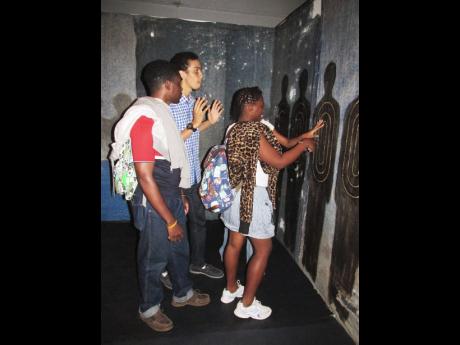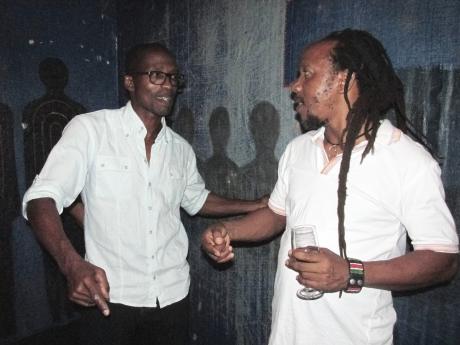Conversation through tar on tarpaulin – The persistence of memory
Some of the signature sights of downtown Kingston market district are old, weathered, frayed plastic tarpaulin stretching from 'pillar' to 'post', fluttering in the wind.
For those who sit, bend or stand beneath them, it is shelter from the elements, from the hardship of life. To some they look unsightly, strong candidates for the garbage dump.
But in them artist Garfield Morgan sees a story, of the Jamaican people who struggle every day to eke out a living, and he is using art, tar on the used tarpaulin, to tell that story of the persistence of memory, of our past and the reality of our present.
So Morgan took the old 'trapallins' and gave the owners new ones or cash. On those tarps Morgan has painted images with tar, images with which and about which to have a conversation.
Creative Arts
Then, on Tuesday, March 1, at the Sir Philip Sherlock Centre for the Creative Arts on the UWI Mona campus, Morgan unveiled Persistence of Memory in the form of a huge three-sided enclosure.
"From the fringes of this society I see tattered and bruised people setting themselves up daily by pulling out tarpaulin to reduce their overexposure to tropical sun while they sweat for their daily bread. The tarpaulin for me is a metaphor for people who demonstrate much resilience in the face of tremendous adversity," Morgan said in his artist statement.
On the left and right panels are painted black silhouettes of people standing close to one another. At the centre, the images are standing apart with concentric circles painted on their torsos as if they are shooting targets.
"They have been marginalised, ignored, and, like the worn tarp, are constantly exposed to the vicissitudes of the environment in which they find themselves ... whether through economic challenges or as part of a social system that condemns them to persistent poverty. The reclaimed tarpaulin encapsulates the lives of these people," Morgan said.
"It holds their stories, their travels, their histories and experiences. I use the tarp as the canvas upon which I explore the human condition. Images recede and reappear in the violent echoes of contemporary existence and non-existence. Within these transformations sight becomes new insight.
In introducing Morgan, UWI lecturer in cultural studies, Dr Jilani Niaah, gave his own insight of Morgan's work. He said he knows Morgan for about 40 year, and he has been on a consistent selfless journey, sharing his passion with those around him. Morgan's approach, he pointed out, is not that of a great authority, but one with a sense of conversation, conversations he's having with himself, and conversations he would like to take into the public domain, yet "he has been able to give us a sense of his own genius as a Caribbean renaissance man, a cultural studies practitioner"
notion of memory
Dr Niaah said Morgan comes with many references, and has chosen a theme that is well referenced within the Caribbean, "the notion of memory, and the persistence of memory". "But outside of referencing those notions, there is a suggestion of other works that we are familiar with, George Beckford's Persistent Poverty, which I think is strongly suggested by the way Garfield has chosen to have a conversation about the tone and fabric of the survival of people in the streets," he explained.
About the physical work itself, Dr Niaah said, "I see this as a kind of mausoleum, he has taken us on a kind of silhouetted historical journey, reminiscent of the hull of misery that we were transported in ... He's done what is very difficult in the context of reality, which is to present misery as art, and in so doing has been able to create a memorial to those that he seeking to engage in a dialogue."
In speaking with Arts and Education about the silhouetted images on the tarps, representing Africans in overcrowded slave ships in the Middle Passage, Morgan said he made them standing up, instead of lying down to represent victory, "and it says much about the endurance, the overcoming, which ... we have in our DNA."
The format of the presentation Morgan said was motivated by a previous installation, and some of the images were in that other set-up. "I challenge myself to continuously expand and do new things and so this challenge was one of those things. "Part of what I do is to present images that invoke conversations. I am not trying to be dogmatic, saying it is this way or that way. People can read all sorts of thing into it." And the essence of the piece he said is about humanity, about people.





